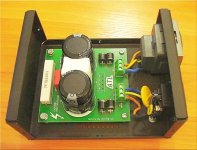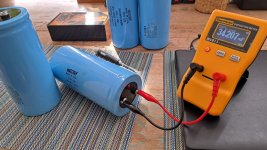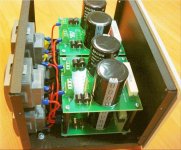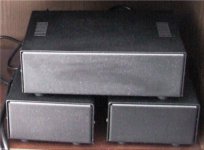That's a clasiic pic of the first incarnation of the QLS.
Micro Seiki DDQ 1000, and probably Crown DC300A amps to bi-amp the speaker.
Levinson ML-2's have no problems to drive them fullrange as the SA/1's.
Micro Seiki DDQ 1000, and probably Crown DC300A amps to bi-amp the speaker.
Levinson ML-2's have no problems to drive them fullrange as the SA/1's.
Yes, these are the Crowns. I wonder what is on the right of the tapedeck.
The one on top looks a bit like a IC-150 Amcron.
Edit: I guess the other one is the OC-150A, also Crown
The one on top looks a bit like a IC-150 Amcron.
Edit: I guess the other one is the OC-150A, also Crown
Last edited:
Probably a tuner, old Accuphase?Yes, these are the Crowns. I wonder what is on the right of the tapedeck.
👉ESR
Understanding capacitor ESR in electrolytic capacitors
https://passive-components.eu/understanding-esr-in-electrolytic-capacitors/
Years ago, I made an update to my DC Blocker prototype (ATL Audio). I changed the big EPCOS 18.000 uF with Mundorf MLGO 47.000 uF -> more bass, better sound.
Understanding capacitor ESR in electrolytic capacitors
https://passive-components.eu/understanding-esr-in-electrolytic-capacitors/
Years ago, I made an update to my DC Blocker prototype (ATL Audio). I changed the big EPCOS 18.000 uF with Mundorf MLGO 47.000 uF -> more bass, better sound.
Attachments
I wonder if your capacity meter gives different values, since the ESR meter specs an upper limit of 22.000µF, despite the fact that you still get readings above that.I have a capacity meter also
Aside: This small distance of the loudspeakers is correct: it also maps the mono sound events as ON!
Even in large rooms and halls, the speaker placement is to be determined by starting with a very small distance, < 1 meter. Then gradually move them apart until the sound image breaks apart: then they are to be moved together again. Also the vast majority of large loudspeakers have only a quite small imaging size, so that speaker distances over 1.5 meters will be veeeeery rare!
Of course, any other conceivable set-up is allowed: across the hut, otherwise;-)
Seems a good working practice! My wife disagrees ;-)Even in large rooms and halls, the speaker placement is to be determined by starting with a very small distance, < 1 meter. Then gradually move them apart until the sound image breaks apart: then they are to be moved together again.
Thanks for the article.👉ESR
Understanding capacitor ESR in electrolytic capacitors
https://passive-components.eu/understanding-esr-in-electrolytic-capacitors/
Years ago, I made an update to my DC Blocker prototype (ATL Audio). I changed the big EPCOS 18.000 uF with Mundorf MLGO 47.000 uF -> more bass, better sound.
Can you explain how increasing the capacitance in a DC-blocker can enhance the bass and sound of your audio rig?
I did however experience these effects when I perform this operation with my poweramplifiers especially in the lower registers.
ESR is virtually (nearly) irrelevant in listening practice. What is heard are materials, cross-section, shape, "mass-stiffness ratio" and other things: cleanliness, purity, co-play of "frequencies", of colours and contours, that sort of thing. Unfortunately, only the listening test provides information about the suitability for listening purposes)-;
You mean in loudspeakers?ESR is virtually (nearly) irrelevant in listening practice. What is heard are materials, cross-section, shape, "mass-stiffness ratio" and other things: cleanliness, purity, co-play of "frequencies", of colours and contours, that sort of thing.
Thanks for the article.
Can you explain how increasing the capacitance in a DC-blocker can enhance the bass and sound of your audio rig?
I did however experience these effects when I perform this operation with my poweramplifiers especially in the lower registers.
I do not know but that is what happened. As I have commented many times over the years, I suffer from a terrible electrical grid (fault of the supplier), with a lot of noise and continuous (years ago, almost 3 Vdc, I know, it sounds incredible). So I started doing tests, with DC blockers, Schaffner RF/EMI filters and Würth 150 kHz ferrites.
In my second audio system, I now have a DC Blocker + DC Blocker x4, with EPCOS 18,000 uF. If I change the DCB to the DCB prototype with Mundorf 47,000 uF I have too much bass, so it is in the main system with a DCB x2.
Attachments
One, the, sound character of a component can be heard everywhere. No matter at which position or with which function. Whether as a crossover component, as a component of an amplifier circuit, as a component of the power supply, or anywhere else. Always and everywhere the one character. In comparision to other components.You mean in loudspeakers?
I am drawing up a power supply PCB for a future amp. I want to add a footprint for radial throughole pin film caps. Does this one look like a nice contender:
https://www.mouser.com/ProductDetail/Panasonic/EZP-V60706MTT?qs=OlC7AqGiEDkRDloJ9EJP/Q==
https://www.mouser.com/ProductDetail/Panasonic/EZP-V60706MTT?qs=OlC7AqGiEDkRDloJ9EJP/Q==
Honestly, I spent time looking for a throughole film cap and like Panasonic and Wima. The options are not great. I would much prefer to use a 250vdc or lower radial TH cap but I haven't seen one much less one that is in stock. With that being said, the size isn't terrible. Footprint eing 42mm x 38.

- Home
- Amplifiers
- Pass Labs
- Film caps in powersupplies





